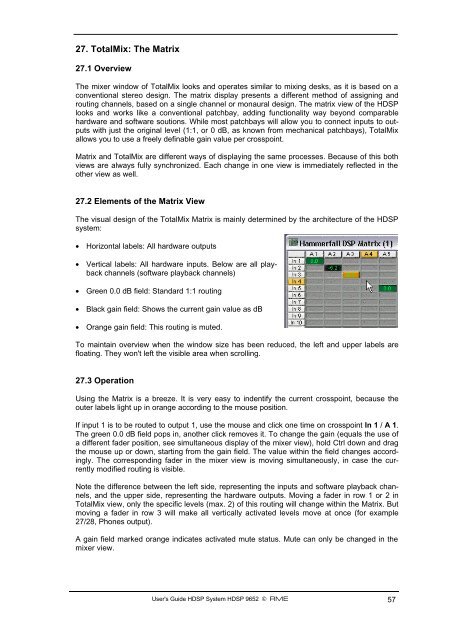You also want an ePaper? Increase the reach of your titles
YUMPU automatically turns print PDFs into web optimized ePapers that Google loves.
27. TotalMix: The Matrix<br />
27.1 Overview<br />
The mixer window of TotalMix looks and operates similar to mixing desks, as it is based on a<br />
conventional stereo design. The matrix display presents a different method of assigning and<br />
routing channels, based on a single channel or monaural design. The matrix view of the H<strong>DSP</strong><br />
looks and works like a conventional patchbay, adding functionality way beyond comparable<br />
hardware and software soutions. While most patchbays will allow you to connect inputs to outputs<br />
with just the original level (1:1, or 0 dB, as known from mechanical patchbays), TotalMix<br />
allows you to use a freely definable gain value per crosspoint.<br />
Matrix and TotalMix are different ways of displaying the same processes. Because of this both<br />
views are always fully synchronized. Each change in one view is immediately reflected in the<br />
other view as well.<br />
27.2 Elements of the Matrix View<br />
The visual design of the TotalMix Matrix is mainly determined by the architecture of the H<strong>DSP</strong><br />
system:<br />
• Horizontal labels: All hardware outputs<br />
• Vertical labels: All hardware inputs. Below are all playback<br />
channels (software playback channels)<br />
• Green 0.0 dB field: Standard 1:1 routing<br />
• Black gain field: Shows the current gain value as dB<br />
• Orange gain field: This routing is muted.<br />
To maintain overview when the window size has been reduced, the left and upper labels are<br />
floating. They won't left the visible area when scrolling.<br />
27.3 Operation<br />
Using the Matrix is a breeze. It is very easy to indentify the current crosspoint, because the<br />
outer labels light up in orange according to the mouse position.<br />
If input 1 is to be routed to output 1, use the mouse and click one time on crosspoint In 1 / A 1.<br />
The green 0.0 dB field pops in, another click removes it. To change the gain (equals the use of<br />
a different fader position, see simultaneous display of the mixer view), hold Ctrl down and drag<br />
the mouse up or down, starting from the gain field. The value within the field changes accordingly.<br />
The corresponding fader in the mixer view is moving simultaneously, in case the currently<br />
modified routing is visible.<br />
Note the difference between the left side, representing the inputs and software playback channels,<br />
and the upper side, representing the hardware outputs. Moving a fader in row 1 or 2 in<br />
TotalMix view, only the specific levels (max. 2) of this routing will change within the Matrix. But<br />
moving a fader in row 3 will make all vertically activated levels move at once (for example<br />
27/28, Phones output).<br />
A gain field marked orange indicates activated mute status. Mute can only be changed in the<br />
mixer view.<br />
User's Guide H<strong>DSP</strong> <strong>System</strong> H<strong>DSP</strong> <strong>9652</strong> © <strong>RME</strong> 57

















